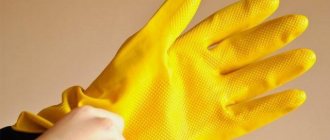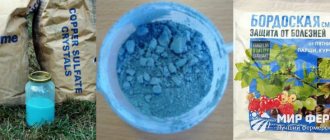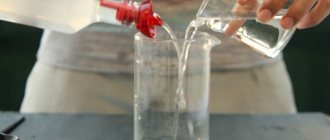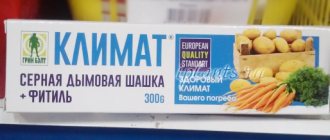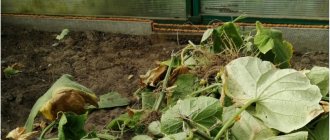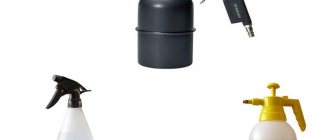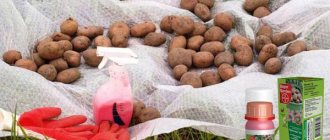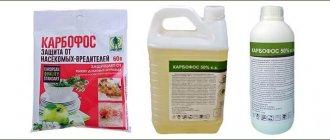What is Bordeaux mixture
Bordeaux mixture is a mixture of solutions of copper sulfate and milk of lime. Refers to protective contact fungicides. It is used in crop production to combat moldy fungi . In addition to a pronounced protective effect, it stimulates crop growth . Used in early spring to disinfect gardens, vineyards and berry fields. Properly prepared liquid is characterized by a blue color, adheres well to the leaves and is retained on the surface of the plants.
Mechanism of action
Fungi that actively reproduce on fruit trees and shrubs, as well as on vegetables, significantly reduce the quality of the crop and lead to the death of plants. To prevent fungal diseases, fungicides are used, which also includes Bordeaux mixture. The copper ions included in its composition destroy spores and colonies of fungi upon direct contact with them. In this case, the chemical does not harm the cultivated plant.
Slaked lime is added to the preparation to prevent burns.
Application cases
Bordeaux mixture is equally effective against most types of fungi that infect crop plants:
- various rots;
- powdery mildew;
- cercospora and late blight;
- olive and hole spotting;
- coccomycosis of stone fruit trees;
- scab.
Symptoms of the lesion
The main symptom of a plant being damaged by a fungal disease is changes in the surface of the leaves:
- the appearance of spots of different colors, blackness or whitish islands;
- darkening;
- the appearance of yellowness at the site of the veins and along the edges of the leaf plate;
- twisting
Fruits are also susceptible to fungal attack, which is reflected in the appearance of dark spots, souring in depth, as well as dryness of berries or root crops.
Composition of Bordeaux mixture
Bordeaux mixture consists of a lime mixture and copper sulfate powder. The main active ingredient of this product is copper compounds that are slightly soluble in liquid, which ensure long-term protection.
But lime and vitriol must be mixed right before use. They are usually packaged in separate bags.
Also, do not forget that depending on the concentration of copper and vitriol, the chemical composition of the solution itself changes. If there is a lack of lime, this can lead to plant burns.
That is why, after checking for alkaline reaction, it should be additionally added.
Cooking recommendations
Bordeaux mixture can have 1% and 3% concentration of the active substance. Accordingly, to prepare it you will need a certain amount of copper sulfate.
3% Bordeaux mixture
300 g of copper sulfate is dissolved in 1–2 liters of hot water. The same amount of lime is dissolved in another container at the rate of 300–400 g of the substance per 2–3 liters of water. Each solution is topped up with cold water to 5 liters. Then they are combined by pouring a thin stream of copper sulfate solution into strained lime milk. The mixture is stirred evenly until it acquires a pleasant blue color.
It is not recommended to use metal containers to prepare Bordeaux mixture.
A properly prepared mixture is characterized by a neutral or slightly alkaline reaction. To check it, use litmus paper, which normally turns blue. If it turns red, it is recommended to add lime milk to the solution until the norm is reached.
Litmus paper can be successfully replaced with a nail or metal wire. In a properly prepared mixture, they do not change color.
1% Bordeaux mixture, preparation
100 g of copper sulfate and the same amount of lime are dissolved in 1 liter of hot and 1 liter of cold water, respectively. The volume of each solution is adjusted to 5 liters, after which the milk of lime is filtered and a solution of copper sulfate is introduced in a thin stream.
Bordeaux mixture is stored for 24 hours, so it is used immediately after preparation and is not stored for future use.
Precautionary measures
Due to the rather pronounced toxicity of the product (class 2 for humans and class 3 for bees), you should work with the liquid in thick clothing, wear gloves on your hands, and a mask and goggles on your face. Drinking, eating anything, and smoking are prohibited. After finishing spraying, wash your hands and face with soap. If drops get on the skin or mucous membranes, rinse them with running water.
It is prohibited to combine Bordeaux mixture in the same solution with FOS and agents that decompose in an alkaline environment. The industrially produced drug is stored for 2 years, the solution is not stored longer than 1 day. It must be used on the day of preparation. The very next day it loses its properties.
When processing beds and gardens, you need to try to ensure that the liquid does not fall on the ground; copper can accumulate in the soil and negatively affect the plants in the future.
How to treat plants
Bordeaux mixture is used in gardening to prevent and treat fungal diseases on fruit trees, berry bushes, as well as grapes and roses.
Fruit trees
Pear, apple and quince trees are treated in the spring, before the start of the growing season, with a 3% solution of copper sulfate at the rate of 10 liters of liquid per 1 adult tree and 2 liters per young plant.
A similar procedure is repeated in late autumn, at the end of the growing season. During active growth of fruit formation and fruiting, a lower concentration of the drug is used. Spraying is carried out so that the solution flows down the branches and trunk and penetrates into all cracks in the bark. Plants are treated in dry weather, preferably in the morning and evening hours, so as not to cause leaf burn by direct sunlight.
Stone fruit trees
The skin of cherries, cherries, plums, peaches and apricots is very sensitive to preparations containing aggressive copper. Therefore, they are sprayed exclusively in early spring, even before the buds open, using a 3% solution of Bordeaux mixture, adhering to the norms for young and mature plants.
Berry bushes
Garden raspberries, gooseberry, strawberry and currant bushes are sprayed in early spring with a 3% solution to prevent fungal diseases.
If they do appear during the growing season, the plants are treated with a preparation of lower concentration, using 1.5 liters of the mixture for every 10 square meters. m. It is recommended to carry out no more than three sprayings per season.
Vegetables
Tomatoes, cucumbers, potatoes and table beets respond best to the use of Bordeaux mixture. They are sprayed during the growing season with a preparation with a 1% concentration. However, the frequency of application differs for each crop. Thus, cucumbers and beets are sprayed no more than 3 times per season, tomatoes can be sprayed 4 times, and potatoes – up to 14 times. The consumption rate of the drug is 1.5–2 liters per 10 square meters. m.
When to use?
Bordeaux mixture in gardening helps to effectively fight most pathogenic lesions on the bark and leaves. In fruit and berry crops, after treatment, a larger number of fruits ripen, and deciduous and coniferous species significantly intensify their growth. In places where bark was removed and on cut branches treated with Bordeaux mixture, rot crusts and darkened areas of wood will not form.
The mixture should be used with caution, since copper compounds are toxic to humans. It is recommended to treat fruit and berry trees 2–4 weeks before harvest.
This improves the quality and stability of fruits during storage, while simultaneously reducing the residual concentration of copper on their surface. There are still disputes regarding the advisability of applying the composition to a summer cottage during the growing season, since the components of the drug can get on earlier fruit-bearing trees or shrubs.
Bordeaux mixture can lead to the appearance of a net structure in fruits and a change in their size. This effect is especially noticeable on cherries. A win-win option is to treat the trees before buds open. During this period, the mixture destroys most microorganisms at the initial stage. Liquids for early treatment of the garden should not be confused with those used during the growing season. A high concentration of active ingredients from the first 3% solution will negatively affect the development of a plant that has already lost its leaves. To treat green plants, use a 1% solution.
How to treat the soil with Bordeaux mixture
Bordeaux mixture is often used to disinfect indoor soil in greenhouses and greenhouses, where pathogenic microflora multiply very quickly. Work is carried out both in early spring and late autumn .
- The first time the soil is spilled with liquid in order to destroy pests, fungal spores and pathogenic microorganisms before the plants begin to grow.
- The procedure is repeated the second time in the pre-winter period, after removing plant remains, foliage and weeds.
Before applying the drug, the soil is dug up and loosened . Treatment is carried out by spraying or watering.
In loosened soil, the product penetrates deeper into the soil and acts more effectively.
Are there analogues of Bordeaux mixture?
Knowing all the difficulties of using Bordeaux mixture, beginners are afraid to use it.
They often have a question about how to replace Bordeaux mixture so that the processing is simple and the effect is high. In fact, there are a huge number of analogues. A good substitute for Bordeaux mixture is Abigo-pik, Hom and Kuproxat. These drugs are no worse in action, and are even much more convenient to use. Their cost is quite affordable. There are also more advanced analogues. These include Oxychomus and Polychomus. They cauterize the sores from above, and also penetrate inside the plant and treat from the inside. But the Bordeaux mixture is not capable of this.
The substitutes listed above are allowed to be mixed with insect poisons. They are combined with many stimulants and fertilizers. So one treatment can solve several problems. But Bordeaux mixture cannot be mixed with anything. The drugs Strobi, Kvardis, Skor, Ridomil, Akrabat and Vectra are very strong. They are many times more effective than Bordeaux mixture.
Negative soil changes
Copper contained in some chemicals, including Bordeaux mixture, quickly accumulates in the soil and is slowly removed from it. This causes slow growth of cultivated plants, the formation of a large number of lateral branches on their roots, a noticeable reduction in yield and even death. That is why the use of Bordeaux mixture in gardening in spring and autumn should be carried out in strict accordance with the recommendations on the packaging.
Area of application of the product and its composition
In gardening, crops are treated by spraying. The liquid is used mainly for treating gardens and vineyards in early spring and autumn and throughout the season; vegetable crops are also processed in season.
The product is used to treat trees and shrubs against a number of fungal diseases: fruit rot, scab, clasterosporiosis, rust, spotting, moniliosis, curl, coccomycosis, anthracnose, septoria; grapes are sprayed against oidium and mildew.
Bordeaux mixture is used on garden crops against late blight, peronosporosis, macrosporiosis, anthracnose, hernaria, cercospora, and rust. It has a gentler effect on plant tissue compared to synthetic products and does not leave burns. The liquid can also be sprayed on flowers grown indoors, as well as treated inside greenhouses, preparing the space for the growing season.
Useful video
A video review from a famous expert will help you learn more about preparing Bordeaux mixture at home.
The use of Bordeaux mixture is one of the most effective ways to prevent and treat fungal diseases that affect crop plants. In addition to protective properties, the mixture has a stimulating effect. In order not to harm the plant and soil, the use of Bordeaux mixture must be carried out in strict accordance with the instructions for the drug and the consumption rates of the substance.
Previous
Tree care
